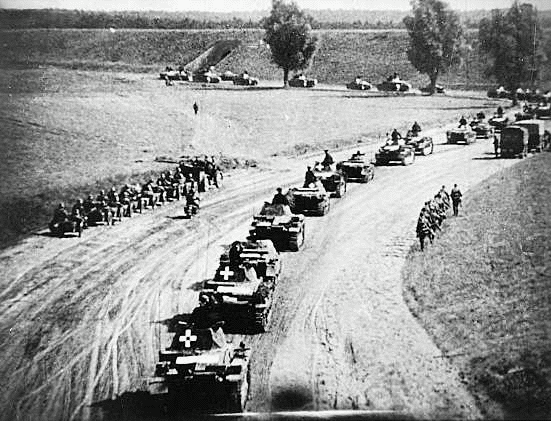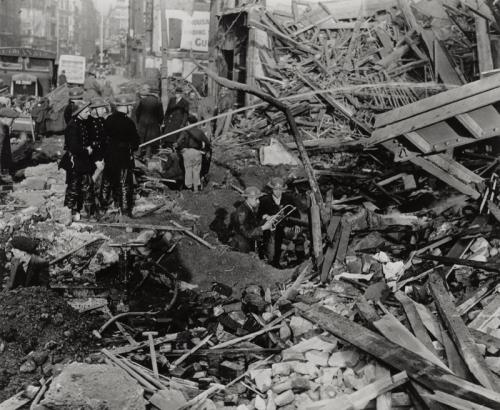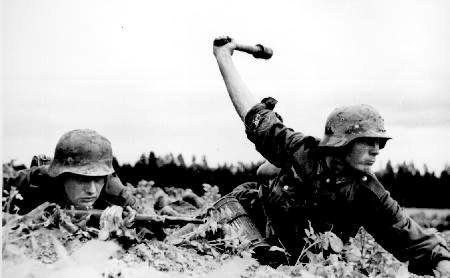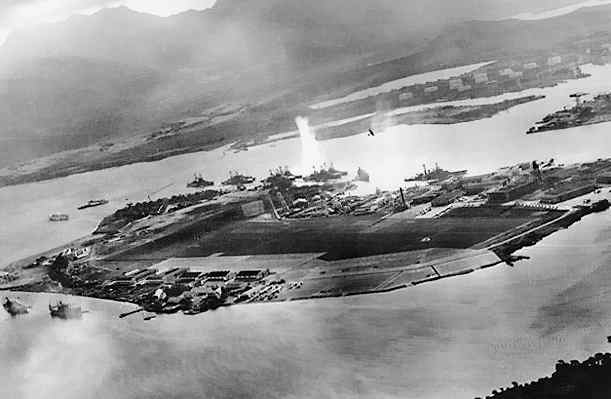Hitler's War:
Blitzkrieg On Poland – Sept. 1939: Blitzkrieg is the term given to Hitler’s particular style of fighting, sending in heavy barrages of bomb and mortar, followed by tanks, heavy infantry, etc, and finally by foot soldiers. Due to this innovative style of fighting, and the massive German forces, the invasion of Poland took less than three weeks. 

The Phony War – 1939-40:
The Phony war was A gathering of French and British troops on the western border of Germany, in which no actual combat took place, conflict was avoided by the allied troops in an effort to attain peace.
Battle of Dunkirk - May 12th 1940: On the 12th of may, german forces had attacked France through the Ardennes forest, an attack assumed to take at least 9 days. However, German troops stormed through these woodlands with the aid on panzer tanks, in little over 50 hours. The fighting in Dunkirk drove the astonsihed french and english coilition troops back, and on may 25th, were called on an evacuation to England.
Battle of Britain - Aug 13, 1940: The struggle of the Luftwaffe to gain air supperiority over the brittish RAF fighters. The battle of Britain left her with little to no air defence, and allowed for the bombing of her critical military areas.

The Blitz - 1940-41:
The sustained bombing of the united Kingdom by Germany, The Blitz inflicted around 43,000 deaths and destroyed over a million houses, but failed to achieve the Germans' strategic objectives of knocking Britain out of the war or rendering it unable to resist an invasion.


Hitler attacks the USSR - June, 1941:
Operation Barbarossa, as it was called; began on June 22, 1941, and was the largest German military operation of World War II. German forces invaded the Soviet Union on June 22, 1941, less than two years after the German-Soviet Pact was signed. Three army groups, including more than three million German soldiers, supported by half a million troops from Germany's allies (Finland, Romania, Hungary, Italy, Slovakia, and Croatia), attacked the Soviet Union across a broad front, from the Baltic Sea in the north to the Black Sea in the south. For months, the Soviet leadership had refused to heed warnings from the western powers of the German troop buildup. Germany thus achieved almost complete tactical surprise and the Soviet armies were initially overwhelmed. Millions of Soviet soldiers were encircled, cut off from supplies and reinforcements, and forced to surrender. 

The battle for Stalingrad - nov 1942 - Feb 1943:
If Hitler was to win this war, he came to the realization that he needed more blood in his army's veins (oil), and hence the logical target was: Stalingrad. When Hitler attacked, and began loosing troops in mass numbers, his generals advised him to withdraw, hitler refused. This refusal to surrender to the superior force of Soviet troops in stalingrad, armed with their knowledge of the land and climate, led the sixth army to Slaughter. The defeat of the German Sixth Army at Stalingrad not only dealt a crippling blow to Hitler's campaign in the East but also marked the strategic turning point of the Second World War, and has come to be recognized as one of the greatest military debacles of all time.

El Alamein - Oct, 1942:
The Battle of El Alamein, fought in the deserts of North Africa, is seen as one of the decisive victories of World War Two. With western Europe narly in complete control of western europe, the control of north Africa became of grave importance. The Afrika corps took El Alamein, and secured defendable positions in North Africa, allowing them to advance, and send more troops to the Russian front, 'wheeling' the german forces.


Invasion of italy - July 1943:
The British eighth army were the first troops to land, and with little Italian resistance, soon took the southern part of Italy around Salerno. This capture of Italy, gave the allies the ability to flank the german troops, and drive them back beyond expectation.

Operation overlord and D-Day - June 1944:
Origionally a "show of good faith" among the soviets and the Western allies. The Invasion of Normandy was the invasion and establishment of Allied forces in Normandy, France during Operation Overlord in World War II. This was the largest seaborn attack of the war, involving over 850,000 troops crossing the English Channel. The overwhelming forces brought on by England, france, the united States, and other coilition troops, drove German forces back, beyond the beaches of normandy.



Germany Surrenders - may 1945:

The Rise and Fall of Japan:
Pearl Harbour:
The 7 December 1941 Japanese raid on Pearl Harbor was one of the great defining moments in history. A single carefully-planned and well-executed stroke removed the United States Navy's battleship force as a possible threat to the Japanese Empire's southward expansion. Attacking just before eight Am, with aerial power unseen thus far of any oceanic air raid, Within a short time five of eight battleships at Pearl Harbor were sunk or sinking. This attack on American soldiers and civilians led to the induction of America into the war.

The Japanese Conquest 1941-1942:
An historic event in which the japanese sweapt through south east Asia, first Malaya, and then Singapore. Under the command of Tsuji Masanobu, as well as a team of 30 military officers, the Japanese Army stormed the British stronghold in Singapore. Under the command of General Yamashita Tomoyuki, the Japanese landed almost simultaneously at Singora, Thailand, and Kota Bharu (Just to the south of Malaya), in order to seize the air fields. The RAF and RAAF were in full retread, and singapore and malaya had fallen.

Battle of the Coral Sea - May 1942:
southwest of the Solomon Islands, was the Japanese attack on allied ships, whose primary goal was an invasion of port moresby. The initial fighting of may 3-6, and may 7-8 cost the United States one aircraft carrier, a destroyer and one of its very valuable fleet oilers. However, the japanese Navy was unable to execute it's Moresby invasion due to heavy damage sustained during this battle. Though the Japanese had "won" this battle, the diversion of resources in order to fuel this battle, would play a major part in the events of the Battle of Midway, a month later.

Midway:
The Battle of Midway was a major naval battle in the Pacific Theater of World War II. It took place from June 4, 1942 to June 7, 1942, approximately one month after the Battle of the Coral Sea. The United States' Navy crushed a Japanese attack against Midway Atoll, losing one aircraft carrier and one destroyer, while destroying four Japanese carriers and a heavy cruiser.
The battle of Midway was a decisive victory for the united States, and is held in nhigh regard as the most outstanding pacific turning point of World War II.

Hiroshima/Nagasaki:
Eleven months after the Makurazaki Typhoon had struck Japan, America destroyed what was left with her trump card. After six months of bombing of 67 major japanese Cities, the Atomic weapon "little boy" was dropped on hiroshima on Monday, aug. 6, 1945. Three days later, the atomic weapon known as: "fat man" was dropped on the Japanese Island of Nagasaki. This was the first true test of atomic weapons, and had now shown the world community just what these weapons were capable of. These attacks killed as many as 220,000 people, and injured many more, and are heralded as "The bloody end, to a bloody war."
 Japan Surrenders/V-J Day:
Japan Surrenders/V-J Day:
In August 1945, the Japanese situation was desperate. The major cities were devastated by atomic or conventional attack, and the casualties numbered in the millions. Millions more were refugees, starvation was apparant, The fleet was lost, Oil stocks were gone, rubber and steel were in short supply, and the Soviets were moving against the only sizable forces the Japanese had left, the Kwantung Army in Manchuria. They were a starving and undersupplied force. Many divisions had transferred to the Pacific, where they died in the island battles. At noon Japan standard time on August 13, 1945, Emperor Hirohito's announcement of Japan's acceptance of the terms of the Potsdam Declaration was broadcast to the Japanese people over the radio. And on the 15th, president Truman accepts the surrender. On september 2nd, the official surrender ceromony is conducted, and Truman declares this "V-J Day."
The death of millions of people in the Second world war, gave birth to a new world order: The United Nations. and while this order is still fledgling, and as any human system must be: impefect, hopefully this council will be able to stop bloodshed before it ever occurs again.
International Confrontation and Cooperation: A motive is a thought or feeling that makes people or nations act in certain
ways. Motives are the result of circumstance, desire, or even fear. When people or nations confront one another, they do so
because of a variety of motives. Some motives for confrontation are nationalism, ethnocentrism, and a desire for
independence, expansionism, or differing ideologies. Over the course of time, the forms confrontation takes have been labeled
and defined. Some of the terms are total war, limited war, guerrilla war, terrorism, brinkmanship, and economic sanctions.
What motivates cooperation? Collective security, internationalism, nationalism, balance of power, humanitarianism, and global
survival. Cooperation can take different forms including alliances, economic blocs, political groupings, international
organizations and agreements.
Global Interactions during the interwar periods and Second World War: Concepts of nationalism, national security,
self-determination, reparations, internationalism, alliances, and global collective security. Justice, human rights,
ideologies.
The Rise and Interaction of the Superpowers: The rivalry for global supremacy has a long history. Today, balance of power
remains one of the key concepts explaining the actions of the superpowers. Concepts include spheres of influence,
decolonization, defense, and self-determination. You will learn that as new nations emerge, superpowers adjust their
foreign policies and reassert their spheres of influence to maintain power.




















 Japan Surrenders/V-J Day:
Japan Surrenders/V-J Day: